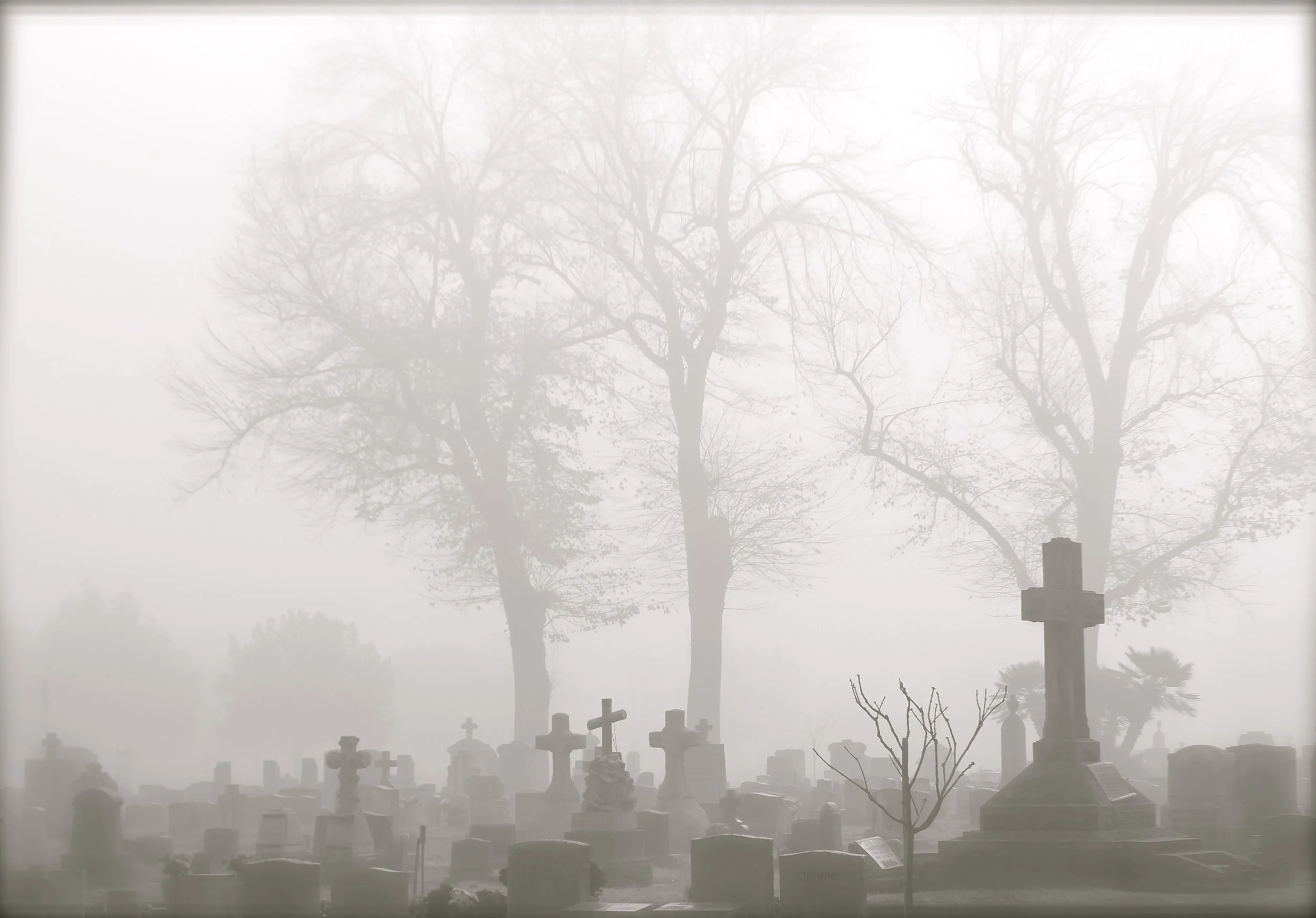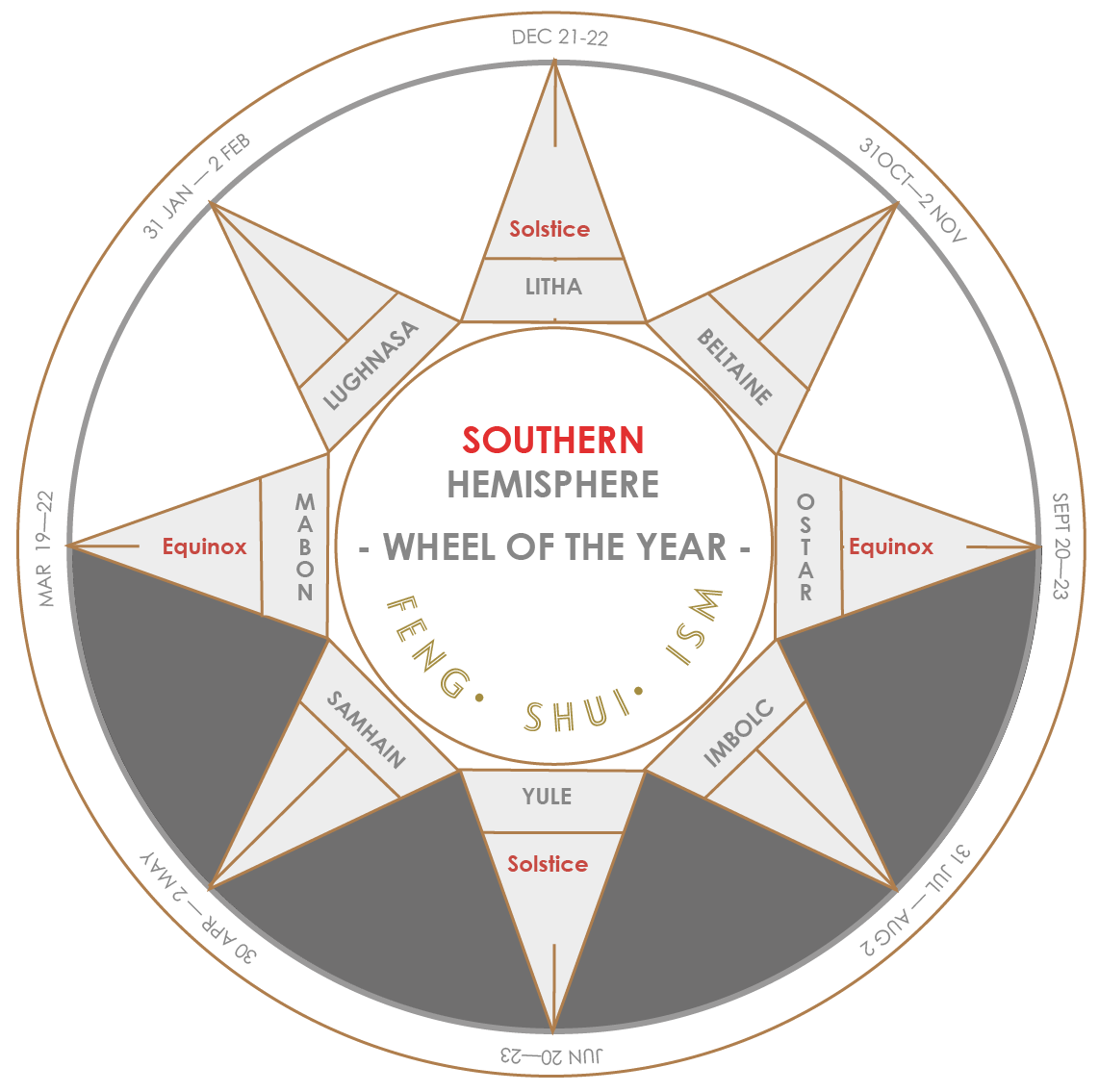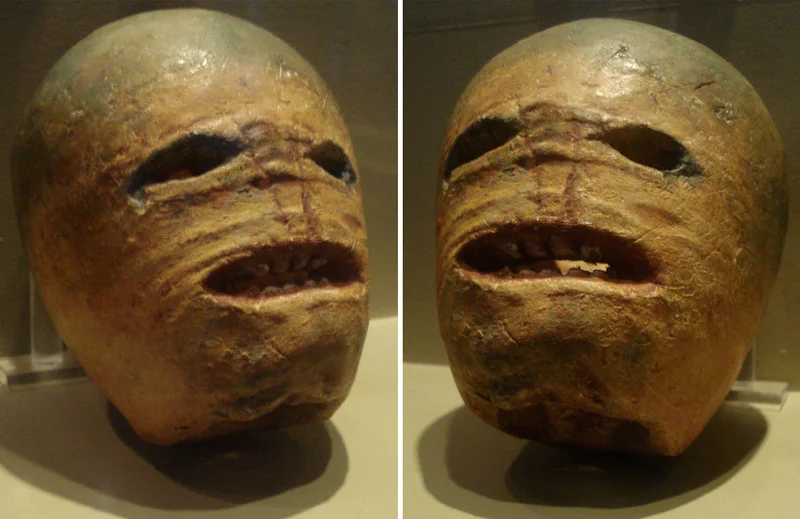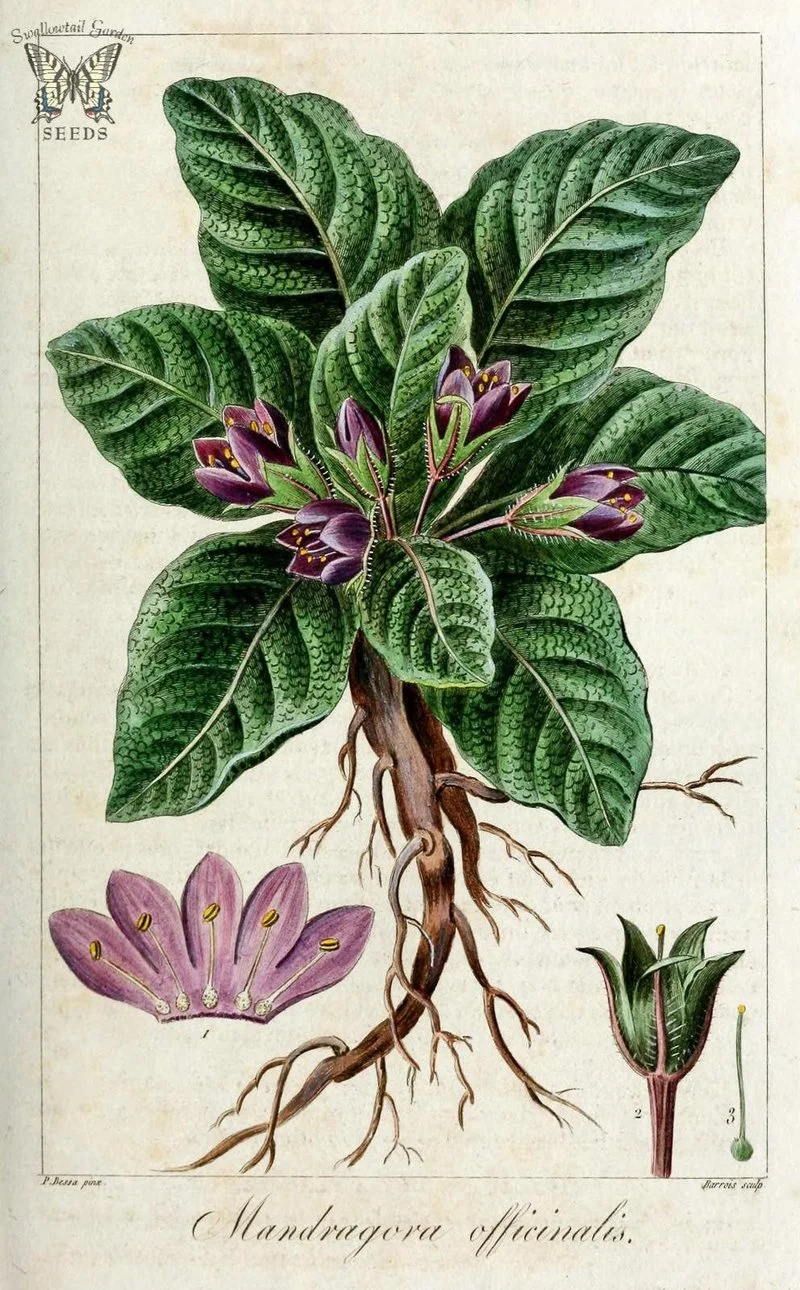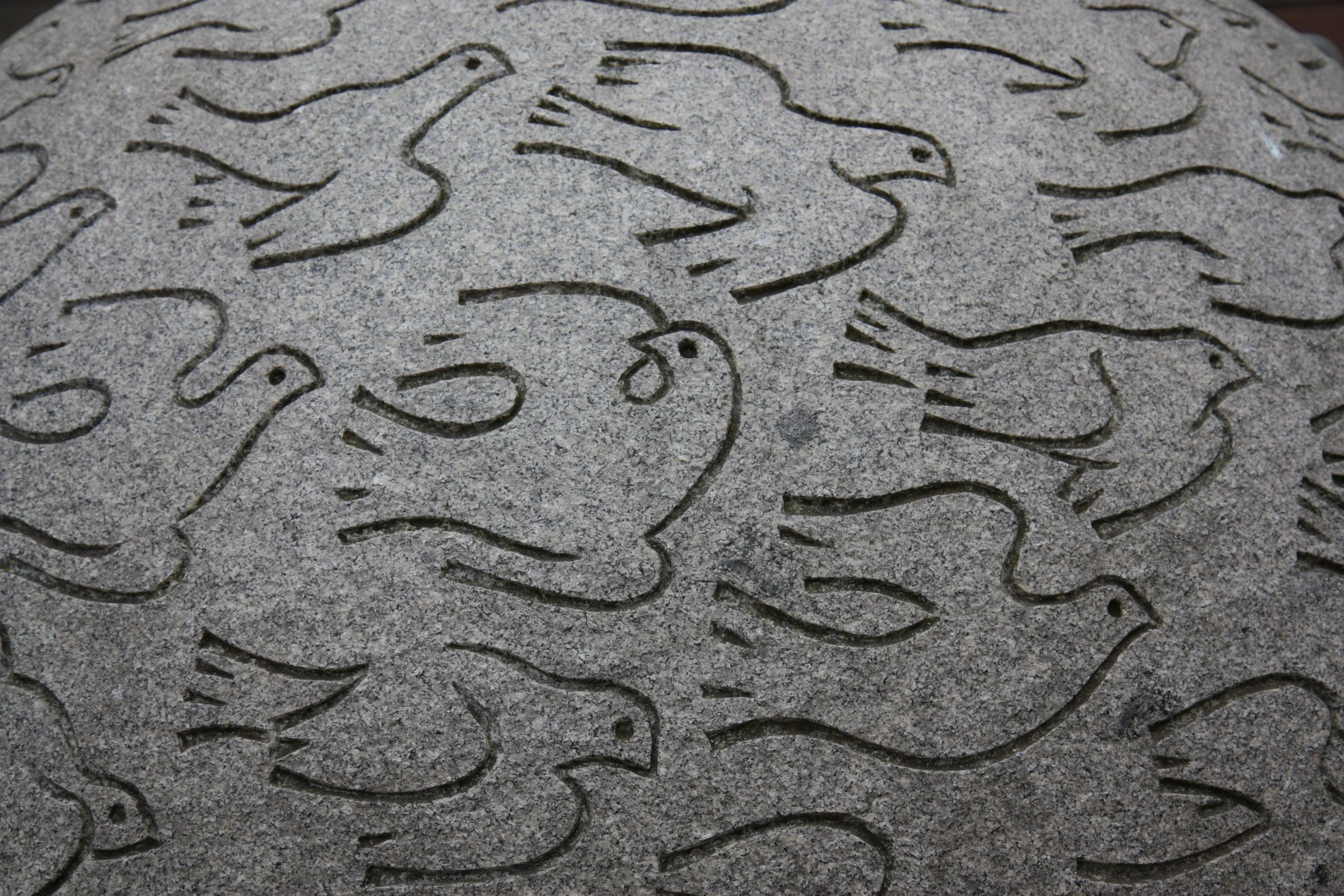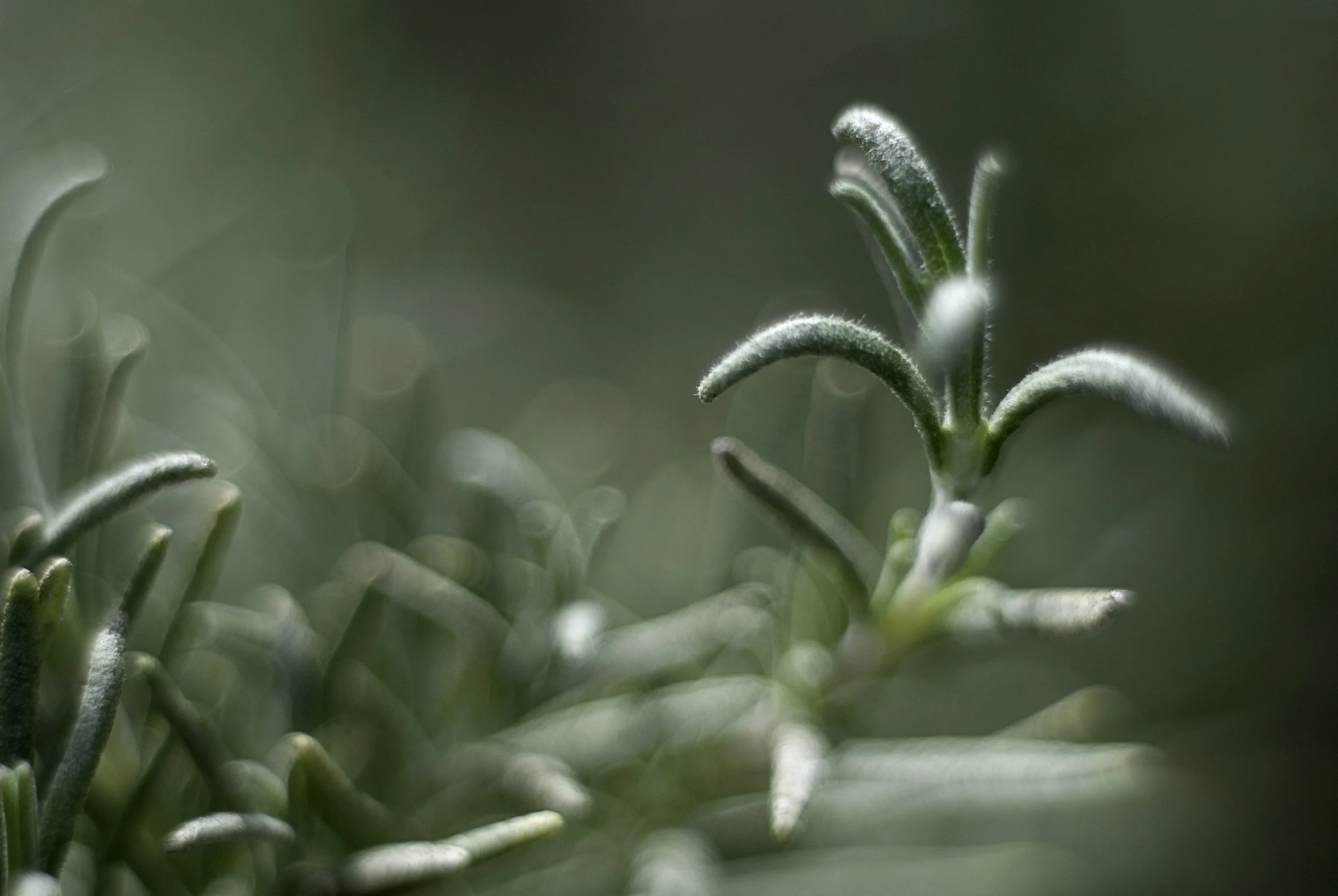At sunset on Oct. 31st, the transition point between two luminaries will exchange the baton from day to night. Forget midnight, it’s sunset that marks the close/ beginning of a Celtic day in their calendar. The last day of Oct. is Hallows Eve, (Hallowe’en) a significant Celtic/Pagan festival marker that’s believed to have marked Celtic New Year’s Eve*. While 1st Nov. is Samhain (or Púka’s day). Folks domicile in the S.H shall be celebrating Beltaine’s Eve. Both markers represent two major festivals or Witches Sabbaths; either the beginning of Summer (S.H) or the beginning of the opposing season of Winter in the N. Hemisphere.
The Celtic/Pagan Wheel of the year is a festival marker, denoting a combination of; the sun’s path on the ecliptic, agricultural cues, religious or pagan veneration as well as seasonal transitions. But we must beat to our circadian rhythm, and honour the upcoming season of where we’re domicile, the season that unfolds before us.
Samhain and Beltaine are intrinsically linked due to polarity; standing opposite on the Earth/Pagan/Celtic Wheel of the Year. Quarter and Cross-Quarter days are represented on the Wheel with the eight-fold year divided into the Equinoxes and Solstices pairs and the remaining four cross-quarter are Old Fire festivals falling midway, marking the beginning of seasons. The Wheel rotates with Samhain (pronounced SOW-in) marking the end and beginning of what some believe was the original ‘Celtic New Year’- when the third and final Harvest has delivered its bounty and the seeds of the winter crops are sown, laying dormant until Imbolc, when nature begins to stir and shown signs of life. By Beltaine the plants are on show and fertility of crops is extremely important. Then at Lughnasad (Lunasa) , the harvest begins and all the crops should be in by Samhain, when the cycle begins once again.
SAMHAIN + BELTAINE CROSSOVER
Native Irish speakers will know that the calendar months of May and November as Beltaine and Samhain respectively. Pagan Samhain (Hallowe’en) is traditionally associated with celebrating the Celtic ‘Summer’s end’ - the dog days of summer - and the decline of the sun. The onset of the Winter sun when the dark half of the year and the deep yin part of nature’s cycle are acknowledged. During Samhain, an old Druid rite coincided with the culmination of the Pleiades cluster that reaches its highest point in the sky – around midnight at this time of year. Of course there are various other dates observed as Samhain, some owing to the Universal Calendar, aka Gregorian calendar which comes from Pope Gregory XIII in 1582 who modified the calendar to keep sync with Easter timing rules. However, some 200 years later in 1752 the United Kingdom and its colonies adopted the calendar and over the course of timekeeping, various other dates were observed; you can read more insights into the all the Wheel of Year astrological dates here and The Calendar Adjustment Act post here.
The opposing seasonal marker of Beltaine (May in N.H or Oct in S.H), celebrates the return of Spring’s solar rays, celebrating the onset of Summer’s Yang sun with early sunrises, warmer earth and the fertile days of Spring on the cusp of Summer. These two power-points on the wheel are the culmination /beginning of seasons.
At Samhain the veils / connection is palpably thin and I feel the compelling draw to honour the sacred Celtic Wheel of the Year. Personally speaking, October 31st is indelibly linked to Samhain and Hallow’s Eve but as I now live in a warmer S. Hemisphere climate I must also honour the opposing festival marker of Beltaine, as it’s represents the season before me. Which can be challenging; given the commercial nuances of Hallowe’en are universally celebrated and on the last day of October (which is a warm month here in Sydney), the ubiquitous pumpkins carvings and ghoulish dress ups are feverishly celebrated. Yet; most fail to take the time to consider the sacred or true meaning of these festivals.
GATEWAYS
The hinge markers are magical portals or gateways, as we edge toward the transitional point of sunset. Samhain and Beltaine are two ‘eves of spirit’ - marking Death and Rebirth. Liminal time rules and the thin veil between our worlds are lifted - ‘thinning veils’ essentially relates to the cycle of life — as nature’s harshest conditions approached at Samhain survival was key and like nature’s hibernation cycle for animals and the plant kingdom’s time of rest — eternal sleep came for both animal and man who couldn’t see the winter through. Therefore many ancestors’ anniversaries were plausibly occurred at this time. Hence the “connection” between the departed are believed to be closer and unhindered between us and spirit denizens of our choice. Beltaine is Springtime; the life-force returns and births in nature, plant kingdom and man were seasonally common as nature warmed up.
WITCHES SABBATH
To Wicca folk both festival markers are two major points of veneration and are equally important nights of the year - May Eve (Beltane April 30th in N.H) and the second sabbath is Hallow’s Eve (Samhain -31st Oct in N.H). Both are known as ‘Witches Sabbath’ but in the N.H during Beltaine (may), a 17th century traditional gathering of Wicca folk celebrates ‘Hexennachtor or ‘Walpurgis Night’. However the German Christian church counteracted tradition by venerating Saint Walpurga on this night — to repel evil magic! Walpurga’s prowess to battle ‘pests, rabies and whooping cough - and some say witchcraft’; perhaps owing to her knowledge of herbal elixirs. She’s oft depicted with potions, a book (spell book?), a crown and crosier. To this day a relic in the form of ‘Oil of Saint Walpurga’ (Walburgis oleum) is said to repel witchcraft! Today’s potion isn’t an ‘oil’, but water that streams over the relic of the Saint; is imbued as a protection remedy. Devotees harvest vials of the ethereal ‘oil’ during Beltaine.
HOW TO HONOUR BELTAINE (May N.H / October S.H)
Beltaine (Irish spelling) - 'Bel' meaning bright or shining and ‘tene' meaning fire or High Spring. It’s a time when the vibrant life force energies burst forth - full of potent potential. 'Bel' aka fire is also part of the Beltaine rituals. Traditionally hearth fires were quenched and reignited again with embers from the Beltaine bonfire. Apparently a ‘bel- fire’ was lit with nine different kinds of wood.
Fertility is abundant during Spring. The air is latent with fecund intentions and stories of the May Queen and King falling in love are common folklore. As is consummation of their union in the open fields, with the dual purpose of bestowing fertility on the lands and resulting in the swollen belly of the May Queen.
Beltaine is also about Hawthorn and fairy trees. Known as the tree of sexuality and fertility, laced with white flowers it’s traditionally used to decorate a Maypole. The sacred herb is used to ward off evil spirits when planted close to homes. Some say May day was the only day when Hawthorn was allowed indoors. And in the Celtic Zodiac system the Hawthorn tree governs from Apr 26 - May 23. (Read more about Hawthorn here) . An old rhyme speaks of it’s powers in reference to Lightning.
“Beware of the Oak, it draws the stroke, Avoid the Ash, it courts the flash. Creep under a thorn, it can save you from harm. ”
MAY POLE RITUAL
A May Poles’ very obvious phallic shape is also linked to fertility and the trailing ribbons topping the pole - normally eight, one for each of the seasonal markers on the Celtic Wheels representing the sun rays and sun God Bel. Half the young Maidens, dressed in white dresses with a crown of white may flowers (hawthorn flowers) danced clockwise - which is also the direction of the sun (deosil) and half counterclockwise, around the Maypole weaving the ribbons. It’s a dance of the Sun’s orbit around the earth. Young men sometimes joined in and dancing in the opposing direction.
The Morris dance is also a beautiful symbolism with eight male (Yang) and female (Yin) dancers intertwining in the figure of eight. Symbolising lovemaking the dancers clasp hands together - the union of hands, also in a figure of eight is called handfasting -'tying the knot’. Couples with a penchant for weddings, notably wed in Spring.
HOW TO HONOUR SAMHAIN (Oct N.H / April S.H)
Just like Beltaine, the Christian church papered over the Pagan festival of Samhain thanks to (Pope Gregory IV in 827-844). All Saint’s Eve on 31 Oct, All Saint’s Day on 1 Nov and All Soul’s Day (all Hallows’ Day) on 2 November. Mirroring the traditional three day Pagan festival observations.
The fae are guardians of the souls of the dead/ghosts of venerated ancestors. Fires were and remain a major way to honour either cross quarter festival marker - the ritual of lighting a fire in particular help me forge a link between these two festivals, Samhain and Beltaine. Fire is cleansing and used to ritually release. Sacred Bonfires oft which often contained animal bones -Bon-fire were lit by altars, where seasonal foods and drinks were offered to appease nature’s land spirits and fairy folk. To this day, pyres are lit on the dark night of Hallows Eve, the hypnotic flicker of flames act as a channel to connect ancestors with the Other-World. Acting as a guiding light; typically lit high on hilltops to show ancestors the way home. True devotees of this significant fire festival tradition only rekindled home fires from a specific hallowed bonfire. The roots of the now ubiquitous Halloween costume lie in the art of disguising oneself against roaming evil of Malefic spirits on the night of Samhain. The aim of mimicking spirit folk (ghosts) when out after dark, meant avoiding detection and safe passage to ones home. Generally Shepherds roamed pastures, taking cattle to stables over the long winter.
Samhain is literally a time to gather the firewood, harvest the last of the fruits, metaphorically take stock as livestock and humans move living activities inside where it’s warmer. Homes are thoroughly cleansed, swept clean and old brooms are discarded and replaced with new, marking the start of the New Year.
The hawthorn tree that’s so intrinsically linked to Beltaine is of course delivering its harvest of red berries in Samhain. In late Autumn the ‘haws’ are used to flavour wines, liqueurs and tonics. It’s not so well known that the tradition of carving autumnal fruits started in Ireland. The abundant supply of turnips made it the produce of choice for Celts’, with Americans substituting them with their seasonal pumpkins. The discarded turnip remains were cooked with herbs and spices of Samhain, eaten as a symbolic dish to banish fear.
The meaning behind the ghoulish carvings were symbolic totems to ward off evil spirits, as the veils were thin and malefic spirits (grim reaper) was thought to also step through. The notion of ‘thinning veils’ is actually more to do with the season of Winter — as natures harshest conditions approached it was a survival of the fittest; and senior often died during this seasonal hinge of the year.
RITUALS + FOLKLORE
Drawing upon rituals and customs that pay homage to a seasonal festival can quell former inner rhythms that now beat to another Hemisphere. Personally, October always triggers the deepest pull between Hemispheres and begin to pine for a non commercial festival when October hits. Halloween back in my Irish homeland, walks in leafy lanes where I trick or treated as a child. Spooky orchards with crab apples, visiting neighbours via torchlight. Never looking back, although never knowing exactly why — but it felt spooky! Returning home in the deepest dark of night after a visit to the local bonfire, with seasonal treats; apples for bobbing apple games, seasonal fruits & nuts and a potato dish called colcannon for dinner. Samhain actually means Feast of Apples.
My maternal grandmother, always baked a tea brack (bram brack). The mixture contained treasure tokens wrapped in greaseproof paper. All young ladies of the household were given a slice and whomever got the prized ring was said to marry next. Should gentlemen wish to learn of his future wife, then he’d forage for 10 leaves of Ivy on the night of Halloween and after discarding one, he should sleep with the rest under his pillow and dream of his true Love – The God Bacchus was the Ivy god.
In the Emerald Isle, should you hear footsteps behind you on Samhain/Halloween night then refrain from the temptation to look behind as if you do, you might be joining the spirits soon. Lore of the Púka was well known, only this version of the Puka was a devilish shapeshifter or malefic fairy who spoilt foods thus deemed inedible. To quell the Puka spirit a "púca's/púka's /Phooka Pooka share" was traditionally offered. Placating hungry spirits in common in many cultures especially China and Mexico’s Day of the Dead. 1 November as also known as Púka's day.
FARMER’S ALMANAC
Like the Celts, the forefathers of Feng Shui, were legendary observers of seasons and nature cycles. Paying heed to fecund land signatures is a governing premise of the ancient art of Feng Shui. The Tong Shu (Chinese Farmer’s Almanac), is also a handy guide to identify the most auspicious days to work with fecund energies.
Sadly in today’s commercial farming practices the notion of certain fruits only available at a specific time of year, is becoming a distant memory. But seasonal fruits were used as significant offering to ancestors past as means of appeasing any unpaid debts and for the afterlife. Talismanic magic also associates certain herbs like mugwort, oak leafs, sage, ivy and straw as sacred to Samhain, while Turnips, Apples, Nuts, Mulled Wine and various meats, as foods of Samhain. Note the ubiquitous pumpkins didn’t feature till Irish kin brought the festival customs to America in famine time — gourds were seasonal in America. Interestingly the autumnal pumpkin in the form of a double Gourd is very significant in Chinese rituals. The waisted gourd form or double bottle gourd / calabash is often hung on the doors to ward off evil! It’s also used is Feng Shui, however I won’t get into that just now.
HARRY POTTER + HALLOWEEN
And finally, I can’t help but reference Harry Potter when discussing Halloween. HP fans maybe surprised to learn that the squeaking Mandrake plant is far from fictitious and really does exist. It has strong links to witches, wizards and Samhain to boot. It’s genuinely ghoulish root features acted as an early Jack-o-lanterns to ward off the evil spirits.
A member of the nightshade family - the tuber potato has significant opiate properties. Which speaks to a witches ability to fly ‘high’ - referencing the more hallucinogenic facet than physical ability!
Talisman makers should also note it’s associated with the planet Saturn. Noting it’s not recommended to ingest or indeed direct skin contact, can transmit the alkaloids in the root which induce excitation and hallucinations, as well as sleepiness—and sometimes comas or death. In short they are highly poisonous, however traditionally they were uprooted, washed and used by skilled herbalists for potion making on Hallow’s Eve.
Oh and did you know Saint Walburga (Walpurga) also inspired ‘Walburga Black’, one of the witches in the Harry Potter books!
Happy Samhain | Beltaine | Witches Sabbath | Saint Walpurga
You can read more about Wheel of the Year festival markers.
* - Celetic New Year’s - James Frazer, The Golden Bough
ⓒ FENG SHUi iSM 2018 - updated 2025
“Living eye to eye with environmental wisdom ”

